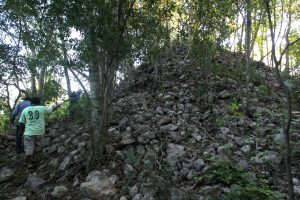By Lourdes Cruz
Cancun, Mexico, Oct 1 (EFE).- People who live on the Yucatan Peninsula, which includes the Mexican states of Yucatan, Quintana Roo and Campeche, consider the ground of the region so flat that under any mound or hill there must hold archaeological treasures, and in many cases that is true.
The rural community of Dos Aguadas in the Jose Maria Morelos municipality, in the Mayan region of Quintana Roo, is a perfect example. Many of its inhabitants are accustomed not only to guarding their lands but also to protecting whatever ruins may lie buried there.

Dos Aguadas is close to Punto Put, which is where the states of Campeche, Quintana Roo and Yucatan border one another geographically; together with Belize and Guatemala they form the Yucatan Peninsula.
One of the main attractions of the Dos Aguadas pyramids is that they are connected by a network of underground tunnels, residents said.
Besides the pyramids that have been partially explored, the inhabitants of the village themselves admit that other ruins once existed in the community, but at the time no one knew what they were and so the locals used them to build walls around a school and around people’s homes.
In Quintana Roo, according to National Anthropology and History Institute (INAH) figures, more than 2,200 archaeological ruins have been entered in the national catalog of archaeological sites and are open to the public.
Besides the large Mayan cities of Tulum, Coba and Kohunlich, all in Quintana Roo, various archaeological digs have shown the presence of Maya settlers across the entire area they used for growing crops.
The 13 archaeological areas open to the public in Quintana Roo for an authorized entrance fee were visited between January and August of this year by more than 44,300 national and foreign tourists.
These areas are El Rey and San Miguelito in Cancun, El Meco on Isla Mujeres, Xcaret and Xel Ha on the Riviera Maya, San Gervasio in Cozumel, Tulum and Coba in the Tulum municipality, Muyil in Felipe Carrillo Puerto, Chacchoben in Bacalar and Kohunlich, along with Dzibanche and Kinichna, and Oxtankah in the Othon P. Blanco municipality.
